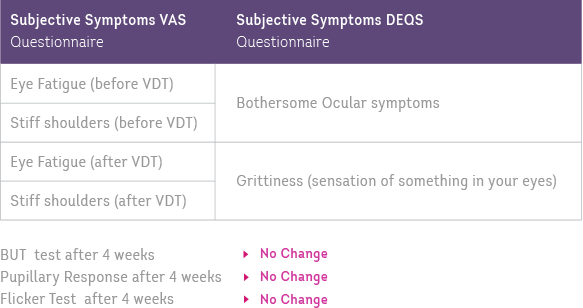Tear Fluid Functions and
Introduction to the Dry Eye Syndrome
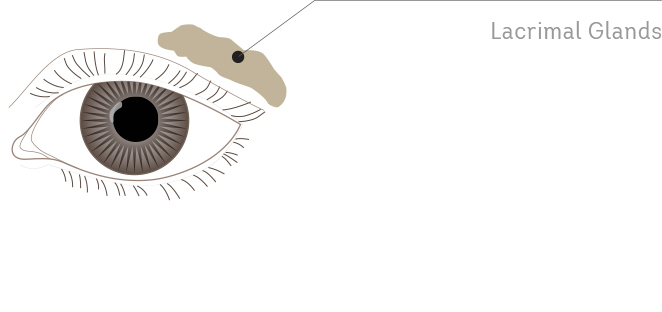
Tears not only provide moisture inside the eye, they also provide nutrients used to nurture cells of the cornea. This is very important due to the lack of blood vessels in the cornea. Besides water, tears provide: Glucose, vitamins, minerals, antibiotics and lipids among others.
Lacrimal glands
- Release tear fluid
Causes of eye dryness:
- Higher age (> 55 years)
- Women more affected
- Work with bright screens
- Contact lenses
- Cigarette smoke
- Certain medications
- Disease (Sjogrens)
Tear fluid defies infections:
- Lysozyme
- Immunoglobins
- Lactoferrin
Symptons of dry eyes:
- Redness
- Stinging
- Itching
- Foreign body sensation
- Sensitivity to light
- Blurred vision
Tear fluid nourishes cornea:
- Glucose
- Vitamin C
- Amino acids
- Minerals
- Humidity
- Mucin (viscosity)
- Lipocalin (carries lipids)
- Lacritin (promotes health of corneal epithelium)
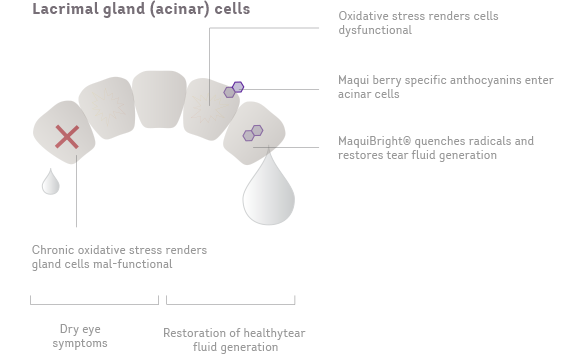
Restores fluid release from lacrimal glands
When the eye suffers from dry eye symptom, it lacks nutrition and protection. In a study performed in cells of the lacrimal gland, it was shown that MaquiBright® was able to penetrate this tissue and suppress inflammatory processes caused by oxidative stress, restoring the normal production of tears.
Maquibright® specific delphinidin species are the active principals
As shown in the graph, one of the exclusive delphinidins present in MaquBright® has a high bioavailability to lacrimal gland cells This allows the cells that have absorbed delphinidin D3G5G to be insulated more effectively from oxidative stress than those provided with anthocyanins present from other products.
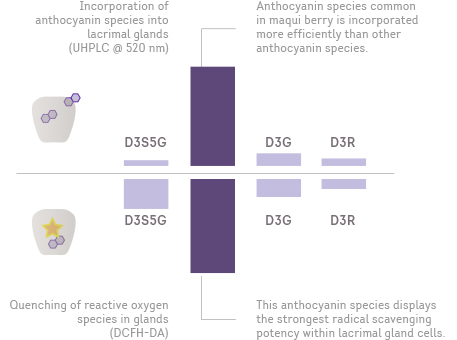
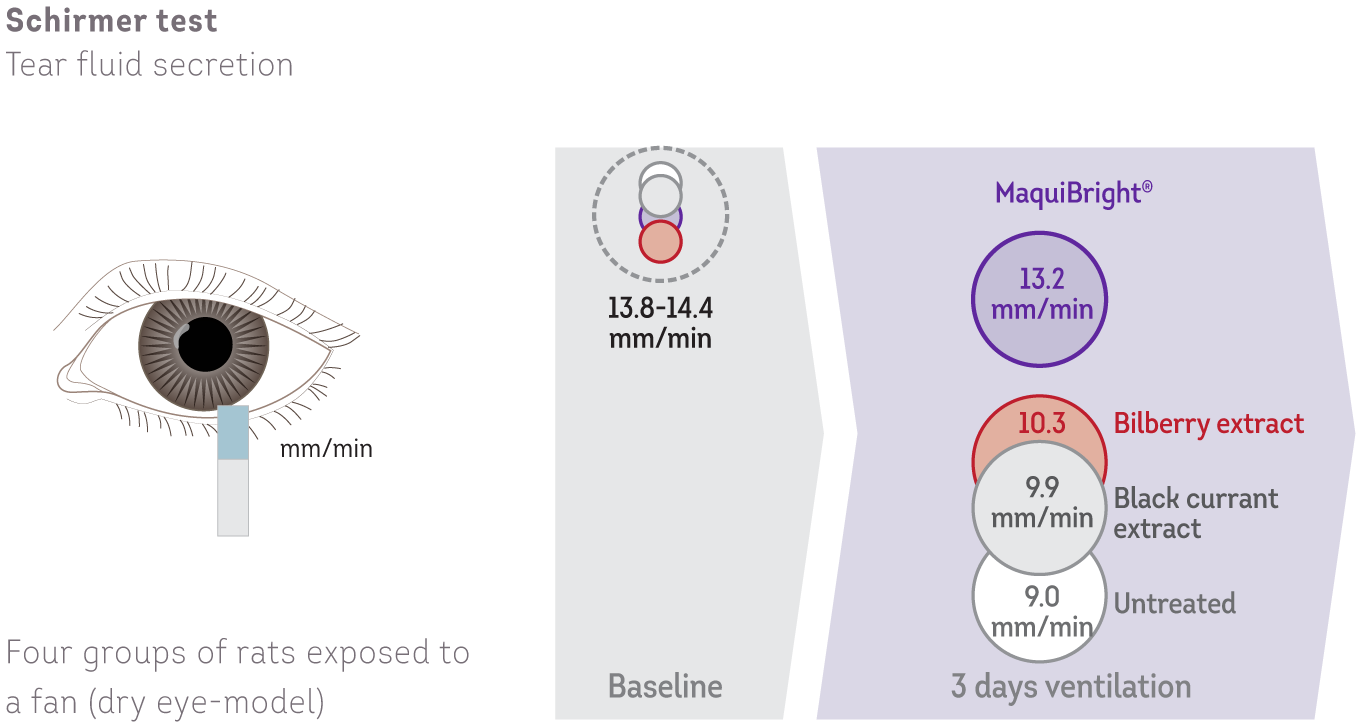
Superior Prevention of Dry Eyes
Four groups of rats were used in this study. The first group was not given diet supplementation (control group), the second group was supplemented with bilberry extract, the third group was supplemented with black currant extract, and the fourth group was supplemented with Maqui berry extract (MaquiBright®). Dry eyes were induced in rats by exposing them to air currents. Initially, each group
of rats had the same tear production, which was measured by the Schirmer test. After 3 days of ventilation, rats presented dry eyes. Those treated with black currant and bilberry extract had a slight improvement compared to the control group. Rats supplemented with MaquiBright® alleviated the dry eye condition to levels of tear production close to those exhibited at baseline.
Dry eye ocular symptoms
Frequency and severity of ocular symptoms
- Sensation of particles in the eyes
- Dry eyes
- Painful or sore eyes
- Ocular fatigue
- The perception of eyelid heaviness
- Eye redness
Questionnaire based on Sakane et al.:Development and validation of the Dry Eye-Related Quality-of-Life Score questionnaireJAMA Ophthalmol 131:1331-1338, 2013
By subjecting volunteers to surveys about how their quality of life had improved, with regards to their dry eye conditionafter use MaquiBright®, the following results were found.
- Difficulty opening eyes
- Blurred vision when focusing
- Sensitivity to bright light
- Problems with eyes while reading
- Difficulty looking at screens
- Feeling distracted due to eye symptoms
- Feeling depressed due to eye symptoms

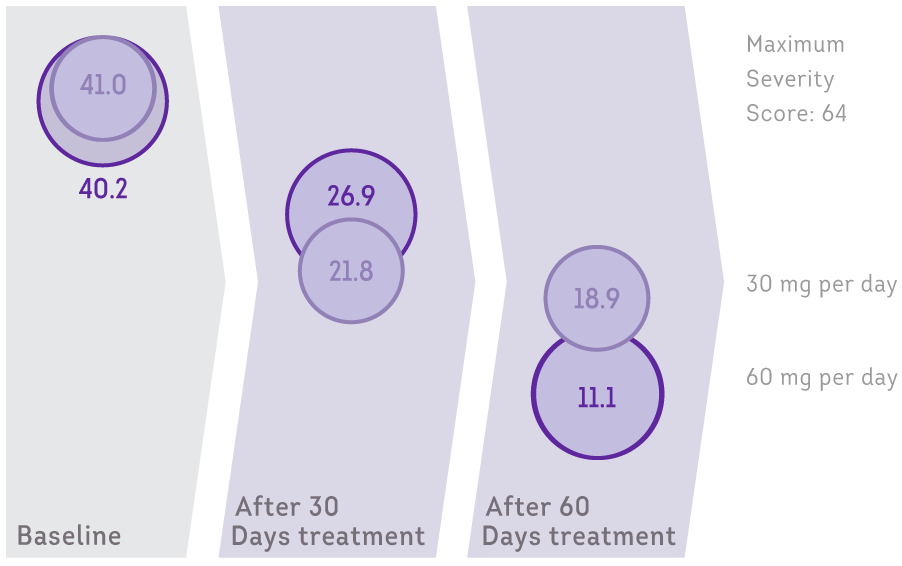
Dry Eye Related Symptoms
With higher dosage treatments, the severity of dry eye related symptoms decreased from moderately severe to nearly a fourth.
MaquiBright®
double-blind study
investigated parameters
- Tear fluid secretion (Schirmer)
- Tear fluid break-up time (BUT)
- Pupillary response (eye fatigue)
- Flicker value
- Subjective symptom evaluation
- -Vas
- -Deqs
Ethical committee board
November 28th 2016 (medical corporation seishin-kai takara clinic)
Study period
November 30th 2016 to july 22nd 2017
Dose
1 capsule per day, intake after breakfast Maquibright® 60mg, dextrin 120mg, placebo 180mg dextrin
Intervention period
4 weeks
Groups
Maquibright® n= 37 (28 women - 9 men), average age 45 (30-60)
Placebo n= 37 (30 women - 7 men), average age 44,5 (30-60)
MaquiBright® Schirmer’s Test
After 4 weeks there is a significant improvement on the following aspects (mm of tear fluid / 5min).
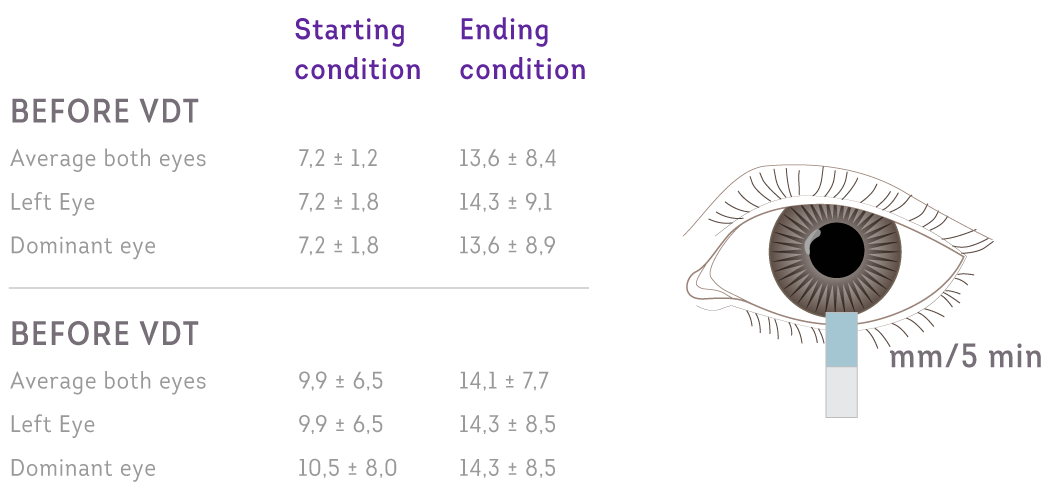
MaquiBright® Schirmer's Test before stress
Normal condition
Patients using MaquiBright® produce 46% more tear fluid than patients with placebo after 4 weeks, p=0,005.
Average tear production for both eyes
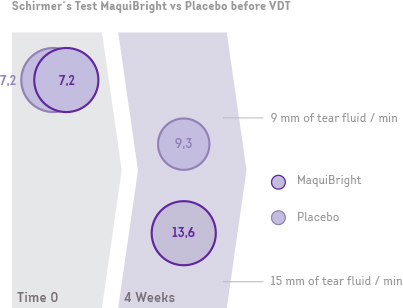
MaquiBright® Schirmer's Test after stress (VDT)
Stressed condition
Patients using MaquiBright® produce 25% more tear fluid than patients with placebo after 4 weeks, p=0,05.
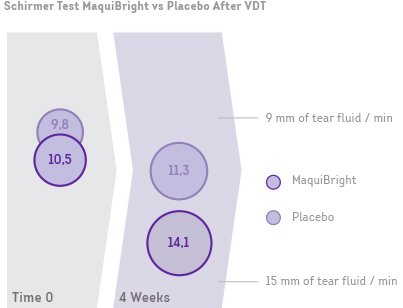
MaquiBright® VAS & DEQS questionnaires
VAS and DEQS questionnaires, the impact of eye dryness on daily life routines.
What Maquibright® has statistically improved for patients.
